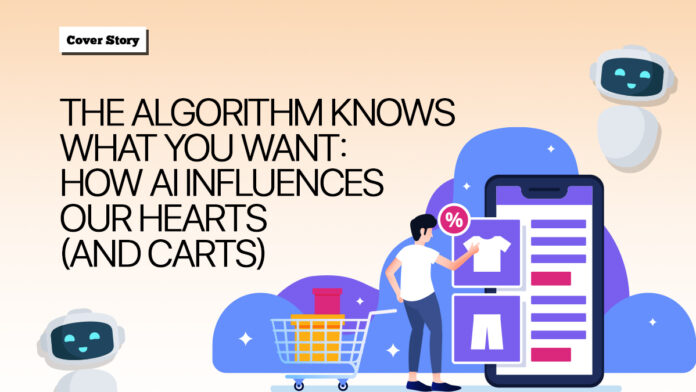Ever get the feeling that your phone is reading your mind? One minute, you’re just mindlessly browsing the internet for a new pair of shoes, and before you know it, your social media sites, search engines, and shopping apps are all coming up with eerily similar items to what you just had in mind. From tech gadgets to fashion accessories, it’s almost as if your gadgets are whispering: “This is exactly what you need.”
In reality, that whisper is artificial intelligence, or AI, working behind the scenes. The algorithm that powers apps, websites, and even your go-to online shopping sites is getting smarter and wiser. They don’t just simply show random things; they scan your preferences, trends, and socials and guess what you’ll want next, often before you do yourself. This is more than a fascinating quirk of modern technology.
How AI Learns What You Like
At the heart of these virtual nudges is machine learning, a form of AI that detects patterns in data. Each time you like a post, swipe by on a story, or tap on a product, your actions are recorded and monitored. Gradually, AI constructs an elaborate profile of your preferences, interests, and even your mood patterns.
Netflix or Spotify, for example, recommends programs or playlists to you based on your tastes, usually before you have actually searched for them. The algorithm is predictive; it estimates chances based on what others with similar behavior have done. The same holds for online shopping; if customers who purchased a yoga mat also bought a set of resistance bands, the algorithm may recommend the bands to you even if you weren’t aware you were looking for them.
This technique, called “collaborative filtering,” is merely one of several methods that online businesses and technology firms employ to guide shopper action. The AI essentially asks: What would people like you purchase next?
The Subtle Push of the Algorithm
AI has become a silent influencer in the way we shop. Every scroll, click, and search is feeding an unseen system that learns our routines and predicts what we will want next. That’s why the shoes you have only looked at once turn up everywhere, from Facebook ads to Shopee recommendations. These algorithms are designed to make shopping feel personal, showing us products at just the right time and in the right way that makes them irresistible.
What makes it even more compelling is how AI appeals to our emotions. Prompts like “only two left” or “trending now” make us feel like we need to act immediately, and offering personalized discounts gives us the impression that the app somehow understands what we need. It’s a clever combination of psychology and information that pushes the boundaries between selection and suggestion. Ultimately, AI doesn’t simply predict our next buy; it quietly shapes it, making us believe it was our idea all along.

The Data Behind the Desire
None of this would be possible without big data. Each search, click, or social interaction is added to a massive store of information. Tech companies analyze this data to identify trends, predict demand, and customize ads to hyper-niche audiences. For example, fashion retailers can track seasonal preferences and even recommend products that match the items you’ve browsed in the past month. In short, big data enables AI to behave like a personal shopper. It is no surprise that users generally find themselves both impressed and slightly discomforted by how accurately online suggestions mirror their wants.
Are We Choosing, or Being Chosen For?
One of the most intriguing aspects of AI commerce is the issue it raises regarding autonomy. If algorithms can predict what we want and push us toward particular buys, to what degree are we really deciding?
A simple example, suppose you are choosing between two laptops. One is well-reviewed, reasonably priced, and slightly older, and the other is brand-new, with lots of flashy features, and heavily advertised on every webpage you click on. You’re likely to be pushed by the AI towards the latter. It’s not necessarily the wrong decision, but it’s no longer yours alone.
This is where behavioral economics comes in. Individuals are likely to act on advice, particularly when it is tailored to them. As an algorithm consistently highlights specific products, they become more likely to be purchased, not necessarily because the product is superior, but because repetition fosters desire.
Not only does AI impact individuals’ decisions, but it also shapes mass trends. Viral items, be they phones or AirPods, gain popularity as algorithms sense growing interest and amplify them on online communities. Social media plays a significant role. Algorithms choose content that keeps users engaged, typically promoting products that generate clicks, likes, or shares. That feedback loop, where AI identifies popular products, boosts their visibility, and drives further engagement, is a trend perceived as natural but is, in part, engineered.
How to Shop Smart in an AI-Driven World
The first step to taking back control from algorithms is simply becoming aware of how they work. It helps to pause and notice when something keeps popping up on your feed and ask yourself if you really want it, or if you’ve just seen it too many times. Read honest reviews, visit other online shops, or even check items out in person. Sometimes, stepping outside the algorithm’s loop reminds you that you still have choices beyond what your screen suggests.
It also pays to take a quick look at your settings. Most apps and social media platforms let you limit data sharing or turn off certain ad personalizations. These little tweaks can make a big difference in what you see online. And when it comes to spending, set boundaries for yourself. Those “limited-time” deals and “only a few left” alerts are meant to push you into buying on impulse. If you take a moment to think it through, you’ll often realize you didn’t really need it after all. The truth is, AI can make life easier and more convenient, but staying mindful ensures that technology serves you, not the other way around.
The Future of AI and Shopping
AI is likely to become even more integrated into our daily lives. Augmented reality shopping experiences, virtual assistants making complete purchases on our behalf, and hyper-targeted marketing campaigns will further obscure the line between human decision and machine influence.
However, this doesn’t have to be bad. AI can improve our shopping experience, leading us to discover products we really need or love — the secret lies in awareness and conscious involvement. Ultimately, the question is not what AI knows but what we do with that information. Are we passive consumers of the online marketplace, or active decision-makers navigating our own wants? As technology develops further, the answer will determine not just our shopping habits but the very nature of consumer culture itself.
Words by Phia Manuell Layoso
Also published in GADGETS MAGAZINE Volume 26 Issue No. 4
